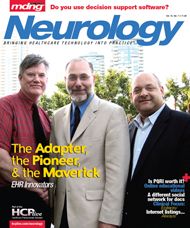Publication
Article
MDNG Neurology
Is the PQRI Process Worth Your Time?
Only 16% of the country’s 700,000 Medicare-participating physicians attempted to submit their PQRI data. Of these, only half—or 8% of the total eligible cohort—were successful in submitting the data correctly.
For those intrepid souls who, for financial gain or belief in the quality initiative, participated in the Physician Quality Reporting Initiative (PQRI) process, much travail was encountered. Only 16% of the country’s 700,000 Medicare-participating physicians even attempted to submit their PQRI data. Of these, only half—or 8% of the total eligible cohort—were successful in submitting the data correctly. The average bonus payment for individual physicians was $600. Additionally, there were tremendous bureaucratic hassles because confusing reports made the allocation of bonuses in a group practice setting extremely difficult.
These hurdles and frustrations were recently described by Dr. Avitzur in Neurology Today. A memo from the AMA to CMS discussed the results from a recent survey of 408 PQRI participants who reported to be frustrated by the program and unable to determine a reason for why their PQRI bonuses were denied. The AMA identified these potential problems with submissions:
Conversion to NPI identification may have been confusing.
Measure applicability validation: some submitted for one or two measures and were (mis)identified as eligible to submit three.
Complexity of measures and coding errors.
Medicare clearinghouse errors: some CMS 1500 claim forms got cut off on the bottom, so quality data codes did not get reported.
However, for healthcare professionals who are interested in qualifying for the 1.5% bonus of their total 2008 Medicare charges, there is still time to submit data in a less-burdensome manner. CMS has defined alternative periods and an alternative means of qualifying data. Instead of charge-based submissions, the alternative method relies on a registry-based reporting system. This means that certain companies have been granted recognition by CMS to report on four “bundles” of PQRI criteria. These four aggregated categories are diabetes, chronic kidney disease, dialysis, and preventative measures.
What does all of this have to do with neurology and your bottom line? One of these registry companies, DocSite, has been a commercial application registry for PQRI reporting. Its registry may be used as a means to report to CMS. However, instead of requiring 80% of all patients within a diagnostic category to have three separate measures, only 30 consecutive patients over 50 seen in the office are needed to qualify for the full 1.5%, with only two needing to have fee-for-service Medicare coverage.
To fulfill the PQRI reporting of preventative care measure by means of a registry, the following is necessary:
The measures that require reporting are:
Plans to follow up on Body Mass Index (kg/m²)? — readily calculated with an ePocrates module
Current tobacco use?
If currently using tobacco, was advice given for quitting?
Screening for colorectal cancer (age ≥ 50)?
Flu vaccine (age ≥ 50)?
Pneumonia vaccine (age ≥ 65)?
For women, the following are also necessary:
Mammogram in last two years (age 50-69)?
Urinary incontinence assessment (age ≥ 65)?
Osteoporosis screening or therapy (age ≥65)?
You can fill in the required data and submit it directly using DocSite, or provide a printable form to be filled out during an appointment, which is then entered by the office staff and submitted. DocSite offers the option to pay them to enter the data from your paper forms for a fee of $150. Submitting data to CMS using the website will cost you $350. WellCentive will also submit your data.
I have been entering data on DocSite for the last few weeks and have accumulated 22 patients that qualify for data submission. Online submission is easily accomplished in the Internet-equipped exam room while evaluating the patient. Despite the fact that I practice neurology, no patient has questioned why they were being asked these questions. In fact, most patients appreciated these questions and interpreted the exchange as an indication of concern on my part about their general health. The only problem with this approach is the need to sign on to the DocSite website for each patient, because the “HIPAA privacy timeout” does not allow you to stay connected in between patients. Since I put my notes into an EHR at the end of the day, I find it more efficient to make notations of the PQRI answers and fill out the online forms while dictating patient notes.
What it boils down to is this: is it worth your time and effort to get the answers to the questions and gamble the $350 registry fee to potentially earn an additional 1.5% of Medicare fees?
For a list of all CMS-approved registry companies, visit www.cms.hhs.gov/PQRI/Downloads/PQRIQualifiedRegistries.pdf.
Dr. Zuckerman is an MDNG Healthcare IT Advisory Board member, and the Chief of Neurology and Medical Information Officer at Baton Rouge General Hospital in Louisiana.






